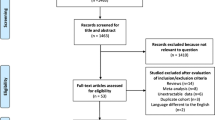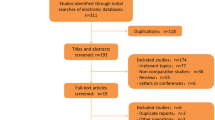Abstract
Objectives
Robotic pancreaticoduodenectomy (RPD) has garnered significant research attention in the last decade. However, no bibliometric studies have been conducted on this field yet. Therefore, the aim of this study is to provide an up-to-date analysis of the current state of research, as well as future trends and hotspots in RPD, through a bibliometric analysis.
Materials and methods
We conducted a thorough search of all literature related to RPD in the Web of Science Core Collection (WoSCC). We then analyzed this literature for a variety of factors, including authorship, country of origin, institutional affiliations, and keywords. To visualize our findings, we utilized Citespace 6.1.R3, which enabled us to create network visualization maps, perform cluster analysis, and extract burst words.
Results
A total of 264 articles were retrieved. Zureikat is the author with the largest contribution in this field, and Surgical Endoscopy and Other International Techniques is the journal with the largest number of papers in this field. The United States is the core research country in this field. The University of Pittsburgh is the most productive institution. According to the data, outcome, pancreas fistula, definition, risk factor, stay, survival, learning curve and experience are recognized as research hotspots in this field.
Conclusions
This study is the first bibliometric study in the field of RPD. Our data will help us better understand the development trend of the field, and determine research hotspots and research directions. The research results provide practical information for other scholars to understand key directions and cutting-edge information.








Similar content being viewed by others
Data availability
The study used all original data are from WOS core database, further inquiries can be directed to the corresponding author.
References
Adam MA, Choudhury K, Dinan MA, Reed SD, Scheri RP, Blazer DG 3rd, Roman SA, Sosa JA (2015) minimally invasive versus open pancreaticoduodenectomy for cancer: practice patterns and short-term outcomes among 7061 patients. Ann Surg 262(2):372–377
Giulianotti PC, Coratti A, Angelini M, Sbrana F, Cecconi S, Balestracci T, Caravaglios G (2003) Robotics in general surgery: personal experience in a large community hospital. Arch surg 138(7):777–784
Kabir T, Tan HL, Syn NL, Wu EJ, Kam JH, Goh BKP (2022) Outcomes of laparoscopic, robotic, and open pancreatoduodenectomy: a network meta-analysis of randomized controlled trials and propensity-score matched studies. Surgery 171(2):476–489
Zureikat AH, Beane JD, Zenati MS, Al Abbas AI, Boone BA, Moser AJ, Bartlett DL, Hogg ME, Zeh HJ 3rd (2021) 500 minimally invasive robotic pancreatoduodenectomies: one decade of optimizing performance. Ann Surg 273(5):966–972
Guo W, Ye X, Li J, Lu S, Wang M, Wang Z, Yao J, Yu S, Yuan G, He S (2022) Comparison of surgical outcomes among open, laparoscopic, and robotic pancreatoduodenectomy: a single-center retrospective study. BMC Surg 22(1):348
Mungo B, Hammad A, AlMasri S, Dogeas E, Nassour I, Singhi AD, Zeh HJ 3rd, Hogg ME, Lee KKW, Zureikat AH, Paniccia A (2023) Pancreaticoduodenectomy for benign and premalignant pancreatic and ampullary disease: is robotic surgery the better approach? Surg Endosc 37(2):1157–1165
Chen C, Song M (2019) Visualizing a field of research: a methodology of systematic scientometric reviews. PLoS ONE 14(10):e0223994
Giulianotti PC, Sbrana F, Bianco FM, Elli EF, Shah G, Addeo P, Caravaglios G, Coratti A (2010) Robot-assisted laparoscopic pancreatic surgery: single-surgeon experience. Surg Endosc 24(7):1646–1657
Zureikat AH, Moser AJ, Boone BA, Bartlett DL, Zenati M, Zeh HJ (2013) 250 robotic pancreatic resections: safety and feasibility. Ann Surg 258(4):554–562
Bassi C, Marchegiani G, Dervenis C, Sarr M, Abu Hilal M, Adham M, Allen P, Andersson R, Asbun HJ, Besselink MG, Conlon K, Del Chiaro M, Falconi M, Fernandez-Cruz L, Fernandez-Del Castillo C, Fingerhut A, Friess H, Gouma DJ, Hackert T, Izbicki J, International Study Group on Pancreatic Surgery (ISGPS) (2017) The 2016 update of the International Study Group (ISGPS) definition and grading of postoperative pancreatic fistula: 11 Years After. Surgery 161(3):584–591
Boone BA, Zenati M, Hogg ME, Steve J, Moser AJ, Bartlett DL, Zeh HJ, Zureikat AH (2015) Assessment of quality outcomes for robotic pancreaticoduodenectomy: identification of the learning curve. JAMA Surg 150(5):416–422
Chen S, Chen JZ, Zhan Q, Deng XX, Shen BY, Peng CH, Li HW (2015) Robot-assisted laparoscopic versus open pancreaticoduodenectomy: a prospective, matched, mid-term follow-up study. Surg Endosc 29(12):3698–3711
Shi Y, Wang W, Qiu W, Zhao S, Wang J, Weng Y, Huo Z, Jin J, Wang Y, Deng X, Shen B, Peng C (2021) Learning curve from 450 cases of robot-assisted pancreaticoduocectomy in a high-volume pancreatic center: optimization of operative procedure and a retrospective study. Ann Surg 274(6):e1277–e1283
Wei TH, Su PJ, Lu WH, Liao TK, Wang CJ, Lai CH, Chiu PH, Su PF, Chao YJ, Shan YS (2022) Minimally invasive approaches increase postoperative complications in obese patients undergoing pancreaticoduodenectomy during the initial development period: a propensity score matching study. Surg Endosc. https://doi.org/10.1007/s00464-022-09773-y
Kim H, Park SY, Park Y, Kwon J, Lee W, Song KB, Hwang DW, Kim SC, Lee JH (2022) Assessment of learning curve and oncologic feasibility of robotic pancreaticoduodenectomy: a propensity score-based comparison with open approach. J Hepatob Pancreat Sci 29(6):649–658. https://doi.org/10.1002/jhbp.837
Tyutyunnik P, Klompmaker S, Lombardo C, Lapshyn H, Menonna F, Napoli N, Wellner U, Izrailov R, Baychorov M, Besselink MG, Abu Hilal M, Fingerhut A, Boggi U, Keck T, Khatkov I, European Consortium on Minimally Invasive Pancreatic Surgery (2022) Learning curve of three European centers in laparoscopic, hybrid laparoscopic, and robotic pancreatoduodenectomy. Surg endo 36(2):1515–1526
Funding
The study was supported by Hospital Management of the General Hospital of Western Theater Command (2021-XZYG-B16), the key research and development program of Sichuan Provincial Science and Technology Department (2022YFS0195).
Author information
Authors and Affiliations
Contributions
All authors have made contributions in this study. YZ and JF collected and prepared preliminary materials, and YZ completed the manuscript writing. LZ and ZZ analyzed and processed the data. HL provided guidance on professional knowledge in the research direction and participated in the writing and revision of the manuscript. KJ conducted the main visual analysis, and participated in the screening and analysis of all literature. RD conducted the final manuscript editing and research design.
Corresponding author
Ethics declarations
Conflict of interest
The authors declare that they have no competing interests.
Additional information
Publisher's Note
Springer Nature remains neutral with regard to jurisdictional claims in published maps and institutional affiliations.
Rights and permissions
Springer Nature or its licensor (e.g. a society or other partner) holds exclusive rights to this article under a publishing agreement with the author(s) or other rightsholder(s); author self-archiving of the accepted manuscript version of this article is solely governed by the terms of such publishing agreement and applicable law.
About this article
Cite this article
Zhao, Y., Feng, J., Liang, H. et al. The future of robotic pancreaticoduodenal surgery: a bibliometric analysis. J Robotic Surg 17, 1943–1954 (2023). https://doi.org/10.1007/s11701-023-01658-z
Received:
Accepted:
Published:
Issue Date:
DOI: https://doi.org/10.1007/s11701-023-01658-z




